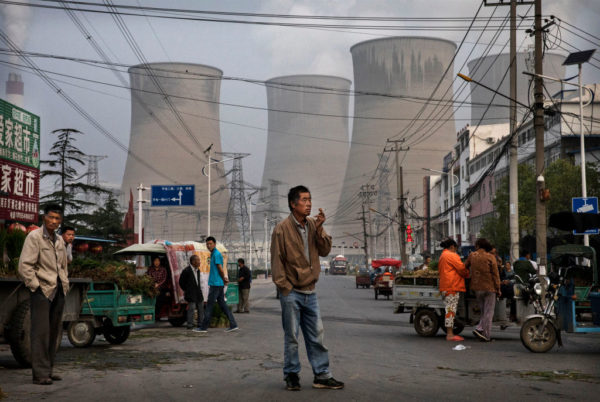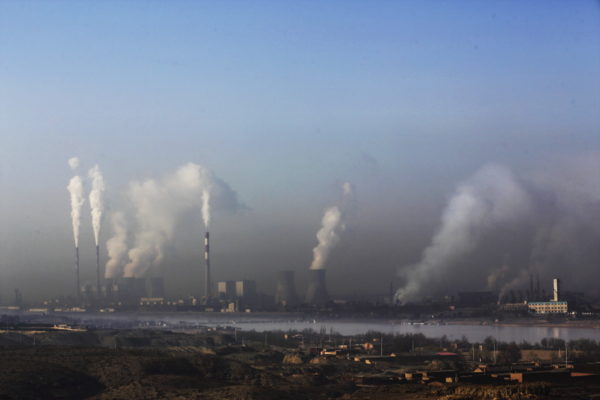China’s coal bubble: 155 coal-fired power plants in the pipeline despite overcapacity

This piece has been updated
China has given the green light to more than 150 coal power plants so far this year despite falling coal consumption, flatlining production and existing overcapacity.
According to a new Greenpeace analysis, in the first nine months of 2015 China’s central and provincial governments issued environmental approvals to 155 coal-fired power plants — that’s four per week.
The numbers associated with this prospective new fleet of plants are suitably astronomical.
Should they all go ahead they would have a capacity of 123GW, more than twice Germany’s entire coal fleet; their carbon emissions would be around 560 million tonnes a year, roughly equal to the annual energy emissions of Brazil; they would produce more particle pollution than all the cars in Beijing, Shanghai, Tianjin and Chongqing put together; and consequently would cause around 6,100 premature deaths a year.
But they’re unlikely to be used to their maximum since China has practically no need for the energy they would produce.
Coal-fired electricity hasn’t increased for four years, and this year coal plant utilisation fell below 50%.
It looks like this trend will continue, with China committing to renewables, gas and nuclear targets for 2020 — together they will cover any increase in electricity demand.
Wasted trillions
What looks to have triggered this phenomenon is Beijing’s decision to decentralise the authority to approve environmental impact assessments on coal projects starting in March of this year.
But it’s been a problem years-in-the-making, driven by the Chinese economy’s addiction to debt-fuelled capital spending.
Almost 50% of China’s GDP is taken up by capital spending on power plants, factories, real estate and infrastructure.
It’s what fuelled the country’s enormous economic growth in recent decades, but diminishing returns have fast become massive losses.
Recent research estimated that the equivalent of $11 trillion (more than one year’s GDP) has been spent on projects that generated no or almost no economic value.
Since the country’s power tariffs are state controlled, energy producers still receive a good price despite the oversupply.
And boy is it a huge oversupply: China’s thermal power capacity has increased by 60GW in the last 12 months whilst coal generation has fallen by more than 2% and capacity utilisation has fallen by 8%.
With thermal power generation this year is equal to what it was in 2011, China has essentially spent four years building 300 large coal power plants it doesn’t use.
Total spend on the upcoming projects would be an estimated $70 billion, with the 60% controlled by the ‘Big 5’ state-owned groups potentially adding 40% to company debt without any likely increase in revenue.
Basically, if these plants get built China’s coal bubble will be inflating faster than ever.

Environmental impacts
Because there’s no room for this much new coal, and because China is sticking to its 15% non-fossil fuel target by 2020, older plants will likely be closed.
Because of that it’s unlikely the new fleet would cause a net increase in carbon emissions, particulate pollution or premature deaths.
To appreciate the sheer scale of the plan, however, here are some of eye-watering stats:
Assuming they operate the same number of hours per year as the most efficient Chinese coal plants did in 2012, these 155 would produce 96,000 tonnes of SO2 pollution, 124,000 tonnes of NOx and 29,000 tonnes of particulates per year.
Modelling suggests that this would cause 6,100 premature deaths a year — that’s 150,000 over a 24-year operating life.
Around Shenyang, where there are reports of record pollution levels 50 times worse than the World Health Organisation’s recommended limit, there are plans for five new coal plants.
Annual carbon emissions of 560 million tonnes would equal 6% of China’s total CO2.
But here’s an oft-overlooked consequence of these coal plants: water.
Nearly half of the proposed power plants are in areas of extremely high water stress, a further 5% are in high water stress regions and another 6% are in arid places.
Demanding at least 310-370 million cubic metres of water every year (which would meet the needs of 5-6 million city dwellers), these projects would exacerbate the conflict between urban, agricultural and industrial consumption.
So they’re not only a waste of money.

